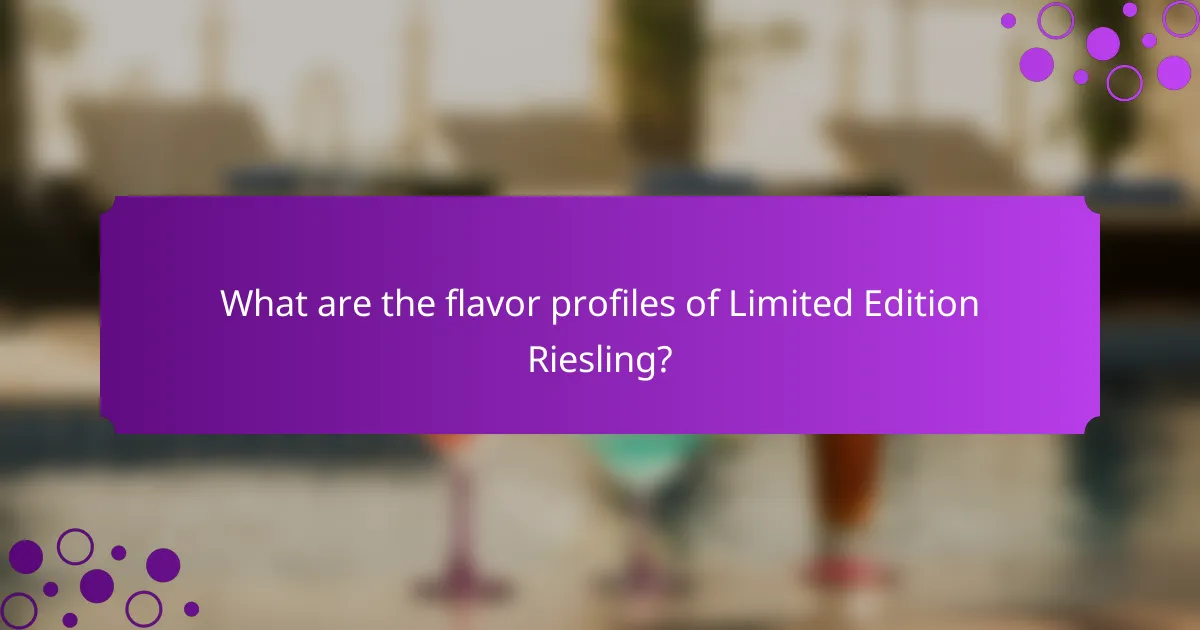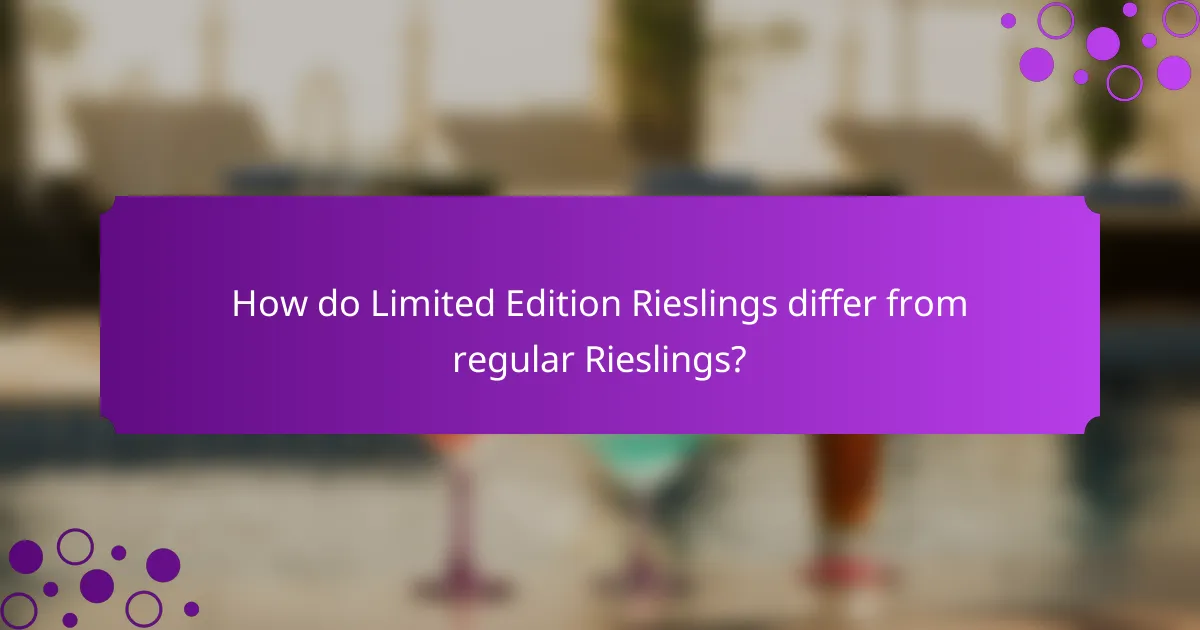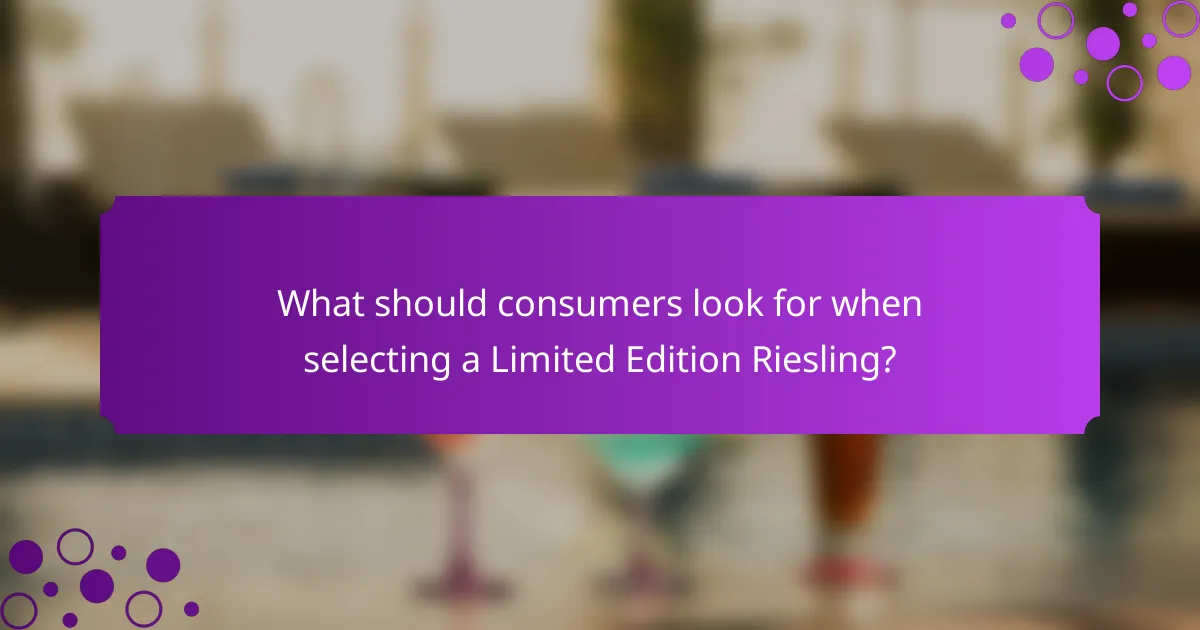
What are the flavor profiles of Limited Edition Riesling?
Limited Edition Riesling typically showcases a range of flavor profiles. Common notes include ripe stone fruits like peach and apricot. Citrus flavors, particularly lemon and lime, are also prominent. Floral aromas, such as jasmine and honeysuckle, enhance the wine’s complexity. Some varieties exhibit mineral undertones, adding depth. The sweetness levels can vary from dry to sweet, depending on the specific edition. This versatility allows for diverse food pairings, enhancing the tasting experience. Each Limited Edition release may present unique attributes based on vintage and terroir.
How do sweetness levels influence the flavor of Limited Edition Riesling?
Sweetness levels significantly influence the flavor of Limited Edition Riesling. Higher sweetness levels typically enhance fruity notes, such as peach, apricot, and honey. This creates a richer, more luscious mouthfeel. Conversely, lower sweetness levels often highlight acidity and minerality. This can lead to a crisper and more refreshing taste. The balance of sweetness and acidity is crucial for overall flavor harmony. For example, a sweeter Riesling may pair well with spicy dishes, while a drier version complements seafood. The specific sweetness level also affects the perception of aromas, enhancing floral characteristics at moderate sweetness. Overall, sweetness levels play a vital role in shaping the unique flavor profile of Limited Edition Riesling.
What are the different sweetness levels found in Limited Edition Riesling?
Limited Edition Riesling typically features four distinct sweetness levels: dry, off-dry, semi-sweet, and sweet. Dry Riesling has less than 10 grams of residual sugar per liter. Off-dry Riesling contains between 10 to 20 grams of residual sugar per liter. Semi-sweet Riesling ranges from 20 to 45 grams of residual sugar per liter. Sweet Riesling has more than 45 grams of residual sugar per liter. These sweetness levels influence the wine’s flavor profile significantly. Each level caters to different palates and food pairings.
How do sweetness levels affect the overall tasting experience?
Sweetness levels significantly influence the overall tasting experience of Riesling. Higher sweetness can enhance fruit flavors and create a richer mouthfeel. It can also balance acidity, making the wine more approachable. Conversely, lower sweetness often emphasizes mineral notes and acidity, leading to a crisper finish. Sensory studies indicate that sweetness affects perception of flavor intensity. For example, a sweeter Riesling may be perceived as more flavorful compared to a dry counterpart. This interaction between sweetness and acidity is crucial for food pairings. Sweetness can complement spicy dishes, enhancing the overall enjoyment of the meal.
What floral aromas are characteristic of Limited Edition Riesling?
Limited Edition Riesling is characterized by floral aromas such as jasmine, honeysuckle, and rose. These floral notes contribute to the wine’s aromatic complexity. Jasmine offers a delicate, sweet fragrance. Honeysuckle adds a rich, nectar-like quality. Rose provides a classic floral essence that enhances the overall profile. Together, these aromas create an inviting bouquet. The presence of these floral notes is often noted in tasting events and wine reviews.
What specific floral notes can be detected in Limited Edition Riesling?
Limited Edition Riesling typically exhibits floral notes such as jasmine and honeysuckle. These floral aromas contribute to the wine’s aromatic complexity. Jasmine provides a sweet, fragrant quality. Honeysuckle adds a rich, nectar-like character. Together, these notes enhance the overall sensory experience of the wine. The presence of these floral elements is a hallmark of high-quality Rieslings. They can be detected through careful tasting and smelling. This aligns with the characteristics noted in wine tasting profiles.
How do these floral aromas contribute to the wine’s appeal?
Floral aromas enhance the wine’s appeal by adding complexity and depth to its flavor profile. These aromas create an inviting sensory experience for consumers. They can evoke feelings of freshness and elegance, which are desirable characteristics in wine. Studies show that floral notes, such as jasmine and honeysuckle, can increase the perception of sweetness. This perception makes the wine more enjoyable to drink. Additionally, floral aromas can complement the wine’s acidity and sweetness, leading to a harmonious balance. The presence of these aromas often indicates high-quality grapes and careful winemaking practices. As a result, floral aromas significantly elevate the overall drinking experience.
What food pairings complement Limited Edition Riesling?
Limited Edition Riesling pairs well with a variety of foods. It complements spicy Asian dishes, enhancing the flavors without overwhelming them. Seafood, especially shellfish, is another excellent match due to the wine’s acidity and sweetness. Light cheeses, such as goat cheese or brie, harmonize with the floral notes in Riesling. Additionally, fruit-based desserts, like tarts or sorbets, accentuate the wine’s sweetness. These pairings are supported by Riesling’s versatile flavor profile, which balances sweetness and acidity effectively.
What types of cuisine work best with Limited Edition Riesling?
Limited Edition Riesling pairs best with Asian cuisine, particularly Thai and Chinese dishes. The wine’s sweetness complements the spice in Thai food. It also enhances the flavors of sweet and sour dishes. Additionally, Riesling works well with seafood, especially grilled fish and shellfish. Its acidity balances rich sauces and buttery textures. Light salads with fruity dressings also match nicely. These pairings highlight the wine’s floral aromas and fruity notes. Overall, diverse cuisines benefit from the unique flavor profile of Limited Edition Riesling.
How does the sweetness level of Riesling affect food compatibility?
The sweetness level of Riesling significantly influences its food compatibility. Dry Riesling pairs well with savory dishes like grilled chicken or seafood. The acidity in dry Riesling balances rich flavors without overpowering them. Off-dry Riesling complements spicy foods, enhancing flavors without adding heat. Sweet Riesling works best with desserts or cheese, providing a contrast that highlights both. The varying sweetness levels create diverse pairing options, making Riesling versatile. Studies show that the sweetness in wines can enhance or diminish the perception of flavors in food. This adaptability makes Riesling a popular choice for various cuisines.

How do Limited Edition Rieslings differ from regular Rieslings?
Limited Edition Rieslings differ from regular Rieslings primarily in their production methods and flavor profiles. Limited Edition Rieslings often come from select vineyards with specific terroirs that enhance their uniqueness. These wines may be produced in smaller quantities, emphasizing quality over quantity.
They frequently showcase distinctive flavor notes that are not present in regular Rieslings. For instance, Limited Edition varieties may exhibit more complex floral aromas and nuanced sweetness levels. Additionally, they may utilize unique fermentation techniques or aging processes that contribute to their exceptional characteristics.
The limited availability of these wines often leads to higher demand and pricing. Regular Rieslings, while still enjoyable, generally offer a more consistent and widely available flavor profile. This distinction makes Limited Edition Rieslings sought after by collectors and enthusiasts.
What unique attributes define Limited Edition Rieslings?
Limited Edition Rieslings are characterized by their exclusive production methods and distinctive flavor profiles. These wines often come from select vineyards with specific terroirs that enhance their uniqueness. They frequently exhibit higher sugar levels, resulting in a sweeter taste compared to standard Rieslings. Limited Edition Rieslings may also showcase rare grape varieties or specific clones that are not commonly used. Their aging potential is often greater, allowing for complex flavor development over time. Additionally, these wines are usually produced in smaller quantities, contributing to their rarity and collectible status. The winemaking techniques employed may include extended skin contact or unique fermentation processes, further distinguishing them from regular Rieslings.
What are the production methods that set Limited Edition Rieslings apart?
Limited Edition Rieslings are distinguished by meticulous production methods. These methods often include selective hand harvesting of grapes. This ensures only the ripest and highest quality fruit is used. Additionally, many producers employ late harvest techniques. This allows grapes to develop concentrated sugars and flavors.
Another key method is the use of specific yeast strains during fermentation. These strains can enhance unique aromatic profiles. Some producers also practice extended aging on lees. This technique adds complexity and depth to the wine’s flavor.
Furthermore, Limited Edition Rieslings may utilize specific vineyard practices. These can include biodynamic farming or low yields. Such practices contribute to the unique character of the wine. Overall, these production methods create a distinctive profile that sets Limited Edition Rieslings apart.
How do limited releases impact the flavor profiles of Riesling?
Limited releases of Riesling often enhance the complexity of flavor profiles. These wines typically come from select vineyards or specific vintages. The limited production allows for meticulous attention to detail during the winemaking process. This can result in more concentrated flavors and aromas.
Limited releases may showcase unique terroir characteristics. Factors like soil composition and microclimate can significantly influence flavor. For instance, a Riesling from a specific vineyard may express distinct mineral notes. These unique attributes can be less pronounced in mass-produced versions.
Additionally, limited releases often feature innovative winemaking techniques. Techniques such as extended skin contact or barrel aging can introduce new flavor dimensions. This experimentation can lead to richer textures and enhanced aromatic profiles.
In summary, limited releases impact Riesling flavor profiles by increasing complexity, showcasing unique terroir, and utilizing innovative winemaking methods.
Why are Limited Edition Rieslings considered special?
Limited Edition Rieslings are considered special due to their unique characteristics and scarcity. These wines often showcase exceptional quality and craftsmanship. They are produced in limited quantities, making them more desirable to collectors and enthusiasts. The grapes used for these editions are typically sourced from select vineyards known for their superior terroir. Limited Edition Rieslings often feature distinctive flavor profiles that highlight rare attributes. Many of these wines age exceptionally well, enhancing their complexity over time. The exclusive nature and unique attributes contribute to their elevated status in the wine market.
What factors contribute to the exclusivity of Limited Edition Rieslings?
Limited Edition Rieslings are exclusive due to their limited production volumes and unique terroirs. The winemaking process often involves meticulous selection of grapes from specific vineyards. These vineyards may have unique soil compositions and microclimates that enhance flavor profiles. Limited Edition Rieslings also frequently utilize traditional winemaking techniques that are not widely practiced. This adds to their rarity and appeal among collectors. Furthermore, the aging potential of these wines often contributes to their desirability. Specific vintages may receive high ratings from wine critics, increasing their market value. The combination of these factors creates a sense of scarcity and exclusivity in Limited Edition Rieslings.
How does scarcity affect consumer perception of Limited Edition Rieslings?
Scarcity enhances consumer perception of Limited Edition Rieslings by creating a sense of exclusivity. When consumers perceive a product as scarce, they often associate it with higher quality. This perception is driven by the idea that limited availability signals a superior product. Studies indicate that consumers are willing to pay more for products they perceive as rare. For instance, a study published in the Journal of Consumer Research found that scarcity influences purchase intentions and enhances desirability. Limited Edition Rieslings, therefore, benefit from this effect, as consumers may view them as more desirable and prestigious. This heightened perception can lead to increased sales and brand loyalty.

What should consumers look for when selecting a Limited Edition Riesling?
Consumers should look for the specific sweetness level when selecting a Limited Edition Riesling. Sweetness can vary significantly, impacting the overall flavor profile. They should also consider the floral aromas present in the wine. Aromas can enhance the tasting experience and indicate quality. Additionally, consumers should check the vintage and region of production. Certain regions are known for producing exceptional Rieslings. Finally, pairing compatibility with food is essential. A well-paired Riesling can elevate a meal, making it more enjoyable.
How can one identify quality in Limited Edition Rieslings?
To identify quality in Limited Edition Rieslings, examine several key attributes. First, check the vintage. High-quality Rieslings often come from specific years known for excellent weather conditions. Second, assess the region of origin. Renowned areas like Mosel or Alsace produce superior Rieslings. Next, evaluate the sugar content. Quality Rieslings balance sweetness with acidity, creating a harmonious flavor profile.
Additionally, observe the aroma. Premium Rieslings exhibit complex floral and fruity notes. Finally, consider expert reviews and ratings. Wines receiving high scores from critics are typically of better quality. These factors collectively help in assessing the quality of Limited Edition Rieslings.
What tasting notes should consumers expect from high-quality Limited Edition Rieslings?
High-quality Limited Edition Rieslings typically exhibit a range of complex tasting notes. Consumers can expect flavors of ripe stone fruits, such as peach and apricot. Citrus notes, including lime and lemon, often add brightness. Floral aromas, particularly jasmine and honeysuckle, contribute to the wine’s bouquet. Many Limited Edition Rieslings also feature mineral undertones, enhancing their depth. The sweetness levels can vary, with some offering a balanced sweetness that complements the acidity. These wines often present a long, lingering finish. The specific terroir and winemaking techniques can influence these tasting notes significantly.
How does label information guide consumers in their selection?
Label information guides consumers in their selection by providing essential details about the product. It includes attributes such as sweetness levels, floral aromas, and food compatibility. Consumers can assess these attributes to determine if the Riesling matches their preferences. For instance, a label indicating a high sweetness level may attract those who enjoy sweeter wines. Additionally, information about floral aromas can appeal to consumers seeking specific flavor profiles. Food compatibility suggestions on the label help consumers envision pairings with meals. Research shows that 70% of wine consumers read labels to make informed choices. This reliance on label information reflects its importance in guiding selections.
What are some tips for enjoying Limited Edition Riesling?
Serve Limited Edition Riesling chilled to enhance its refreshing qualities. A temperature around 45-50°F (7-10°C) is ideal. Use a tulip-shaped glass to concentrate the aromas. This glass shape allows for better appreciation of the wine’s floral notes. Pair it with light dishes like seafood or salads to complement its sweetness. The acidity in Riesling balances well with spicy foods, enhancing the overall experience. Take small sips to fully appreciate the complex flavors. This allows for a better understanding of its unique profile. Enjoying it with friends can also enhance the tasting experience. Sharing thoughts on flavors can lead to a deeper appreciation.
How should Limited Edition Riesling be served for optimal enjoyment?
Limited Edition Riesling should be served chilled at a temperature between 45°F and 50°F. This temperature range enhances the wine’s floral aromas and preserves its sweetness. Using a white wine glass allows for better aroma concentration. Pouring the wine gently helps to maintain its effervescence if it is sparkling. Pairing it with light dishes such as seafood or Asian cuisine complements its flavor profile. Serving it alongside cheese can also enhance the tasting experience. These practices are widely recommended by sommeliers for optimal enjoyment.
What common mistakes should be avoided when pairing food with Limited Edition Riesling?
Common mistakes to avoid when pairing food with Limited Edition Riesling include overlooking sweetness levels. Pairing overly sweet dishes can clash with the wine’s profile. Additionally, neglecting acidity can lead to unbalanced flavors. Foods high in acidity may overpower the Riesling’s delicate notes. Ignoring floral aromas can also lead to mismatched pairings. Dishes lacking aromatic elements may not complement the wine effectively. Finally, serving the wine too warm can diminish its refreshing qualities. Proper chilling enhances the overall tasting experience.
Limited Edition Riesling is a unique wine characterized by its diverse flavor profiles, which often include ripe stone fruits, citrus notes, and complex floral aromas. This article explores the influence of sweetness levels on flavor and food compatibility, detailing four distinct sweetness categories: dry, off-dry, semi-sweet, and sweet. It also highlights the production methods that differentiate Limited Edition Rieslings from regular varieties, emphasizing their exclusive characteristics and the importance of terroir. Additionally, the article provides insights on how to select and enjoy these wines, including optimal serving tips and common pairing mistakes to avoid.